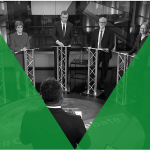
Dr Aljosha Karim Schapals
Lecturer in Journalism and Political Communication in the School of Communication of Queensland University of Technology (QUT) in Brisbane, Australia, as well as a Research Associate in the Digital Media Research Centre (DMRC), where he is working on the three-year ARCDiscovery Project “Journalism beyond the crisis”. He is the lead editor of “Digitizing Democracy”, a major edited collection in the field of political communication, published by Routledge in 2019.
Email: aljosha.schapals@qut.edu.au

Section 7: News and Journalism
- Time to fix our TV debates
- What was all that about, then? The media agenda in the 2019 General Election
- Pluralism or partisanship? Calibrating punditry on BBC2’s Politics Live
- Hero and villain: the media’s role in identity management
- Traditional majoritarian conceptions of UK politics pose a dilemma for the media in elections
- Boxing clever: negotiating gender in campaign coverage during the 2019 General Election
- Press distortion of public opinion polling: what can, or should, be done?
- The final verdict: patterns of press partisanship
- The class war election
- An uncertain future for alternative online media?
The day after the 2016 EU referendum, I took part in a conference at St James’s Park, in central London. When I entered the building, I was met by looks of disbelief and shock of how it had come to this, and how seemingly none of us had predicted the outcome. And although polls suggested a majority win for Boris Johnson under the Conservatives this time around, I had a distinct sense of déjà-vu when I was asked by a stunned colleague: “But how did this happen? Almost everything I saw online suggested it was going terribly for the Tories”. He may be forgiven – my own Twitter feed looked no different: from posts mocking Tory chairman James Cleverly for his inept defence of the indefensible – namely, re-branding the Conservatives’ account as ‘FactCheck UK’ – to outrage of Jacob Rees-Mogg’s contempt for the victims of Grenfell – my followees called them out, constantly – and rightly so. Contrast this with many parts of the ‘traditional’ media, and my sense is that people may have experienced a different election altogether.
Research by the Reuters Institute speaks to this: 52% of the over 45’s cite TV as their main source of news, compared to only 27% for those under the age of 45. Online, the picture looks different: 63% of under 45’s use online media as their main source, compared to only 26% for those over the age of 45. The role of traditional media, and TV in particular, matters: first, their research also suggests that those identifying with the political right prefer to get their news offline (58% combined for print and TV); second, because broadcast agendas are often set by the dominant role of partisan, pro-Conservative newspapers. A tangible example is The Sunday paper review on the Andrew Marr Show, where commentators – among those Sarah Vine, whose husband happens to be Conservative MP Michael Gove – debate the day’s headlines.
And newspaper coverage matters, too: the two with the highest circulations, The Sun and The Daily Mail, both pro-Brexit papers, sell over a million copies a day. And although, as elsewhere, their circulations are declining (from 2010 to 2019, The Sun’s dropped from 3m to 1.4m, while The Daily Mail’s fell from 2.1m to 1.2m), they are still significant in shaping public opinion. In its October 30 leader column, for example, The Daily Mail wrote: “Labour was devising ever more elaborate ways to pick your pocket and flatten the economy … Just take a moment to think of that gruesome prospect”. The Sun went much further: four days before the election, in its three-page ‘Dossier of Doom’, it referred to the Labour leader as “the most dangerous man ever to stand for high office”, before declaring: “Waking up to Corbyn as PM on Friday the 13th would just be the start of a… NIGHTMARE”. Such highly partisan coverage was also a staple in the 2017 election.
Of course, these are just two examples from the two highest-circulating newspapers in the UK. Yet, research by Loughborough University, which measured positive and negative coverage across several papers, suggests that they are emblematic of a wider malaise: in the four weeks of campaigning, coverage was overwhelmingly hostile towards Labour, while the ruling Conservatives were portrayed favourably. Left-leaning exceptions to that rule include The Guardian and The Daily Mirror, but there was little they could do to offset that trend. In ‘traditional’ media, Labour seemed to have lost the battle from the outset.
But when we look online, a different picture starts to emerge: here, as in 2017, smaller, alternative outlets left their mark, too – many of which came out in strong support for Corbyn. These include The Canary, Evolve Politics, Novara Media, Skwawkbox and Another Angry Voice. The latter is particularly interesting: operating as a ‘one-man show’ (the blog is written by Thomas G. Clark, an English tutor from West Yorkshire), its accompanying Facebook site consistently achieves levels of traffic usually expected of mainstream media. His post on election night has, at the time of writing, attracted 13k interactions (‘likes’, comments and shares combined), while his take on Johnson’s repetitive ‘get Brexit done’ soundbite (‘Get Boris done’) has attracted more than 2k on the same day. The only other two ‘alt-media’ on the right-wing spectrum include Guido Fawkes and Breitbart – both however attract lower engagement levels. In the mainstream media, the Guardian’s excellent ‘Anywhere but Westminster’ series provide an alternative viewpoint, too – away from the Westminster bubble and the Commons chambers.
Yet, despite their value, we know now that they were unable to cut through the noise of Johnson’s ‘get Brexit done’ soundbite. The last week of campaigning even saw Johnson break through a foam wall with a bulldozer carrying the phrase to ‘break the gridlock’. The following day, the stunt featured heavily on the two conservative, Eurosceptic newspapers, the Daily Express and The Daily Telegraph. Often featured, but less often scrutinised, in an election campaign that sowed confusion and peddled misinformation, he, ultimately, got away with it. Lesson learned? That despite the rise of alternative outlets, it’s the mainstream media that continue to set the agenda. The demographic divide, and the different media diets we consume, may well explain why this was, perhaps, a tale of two elections.
